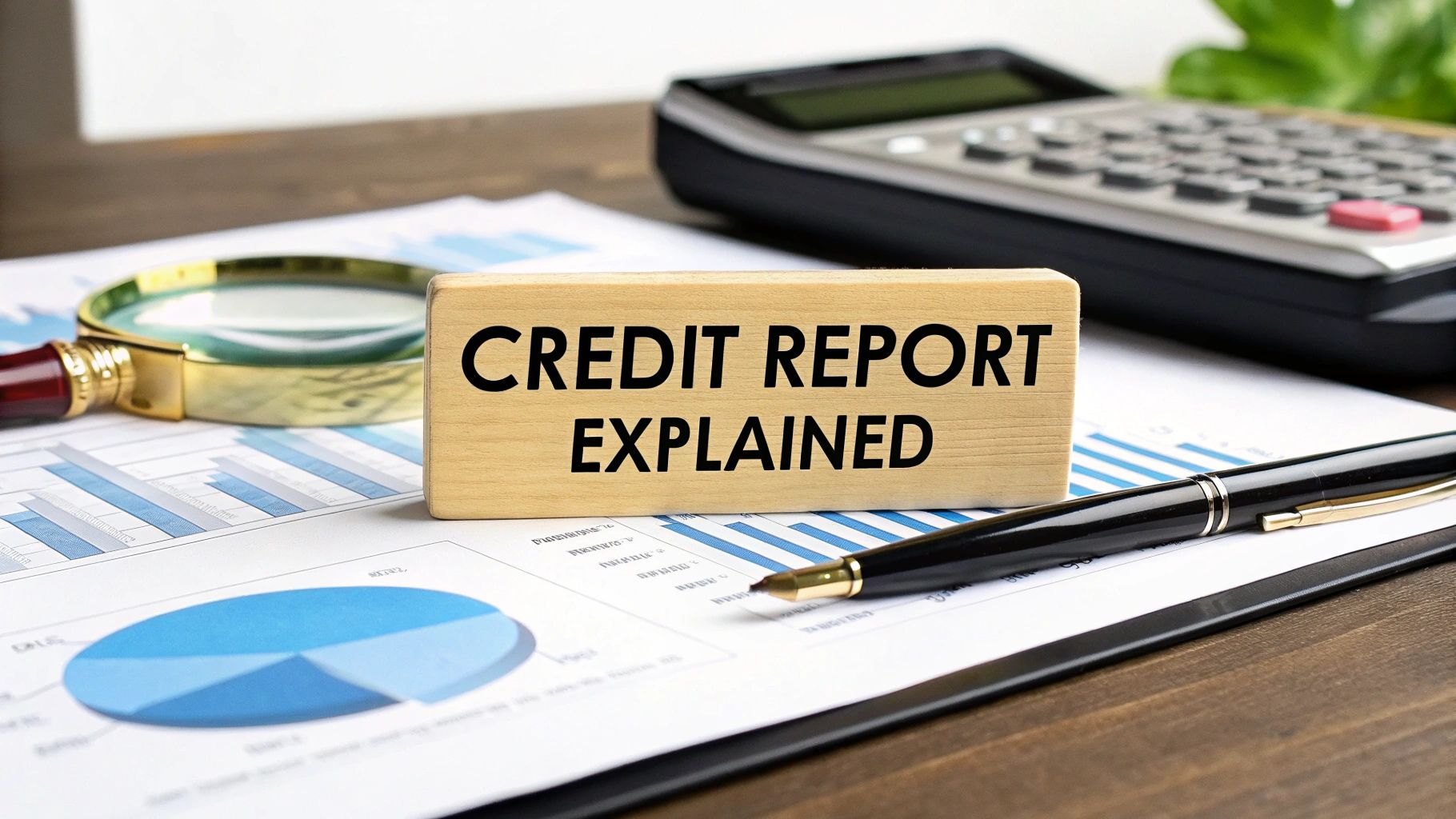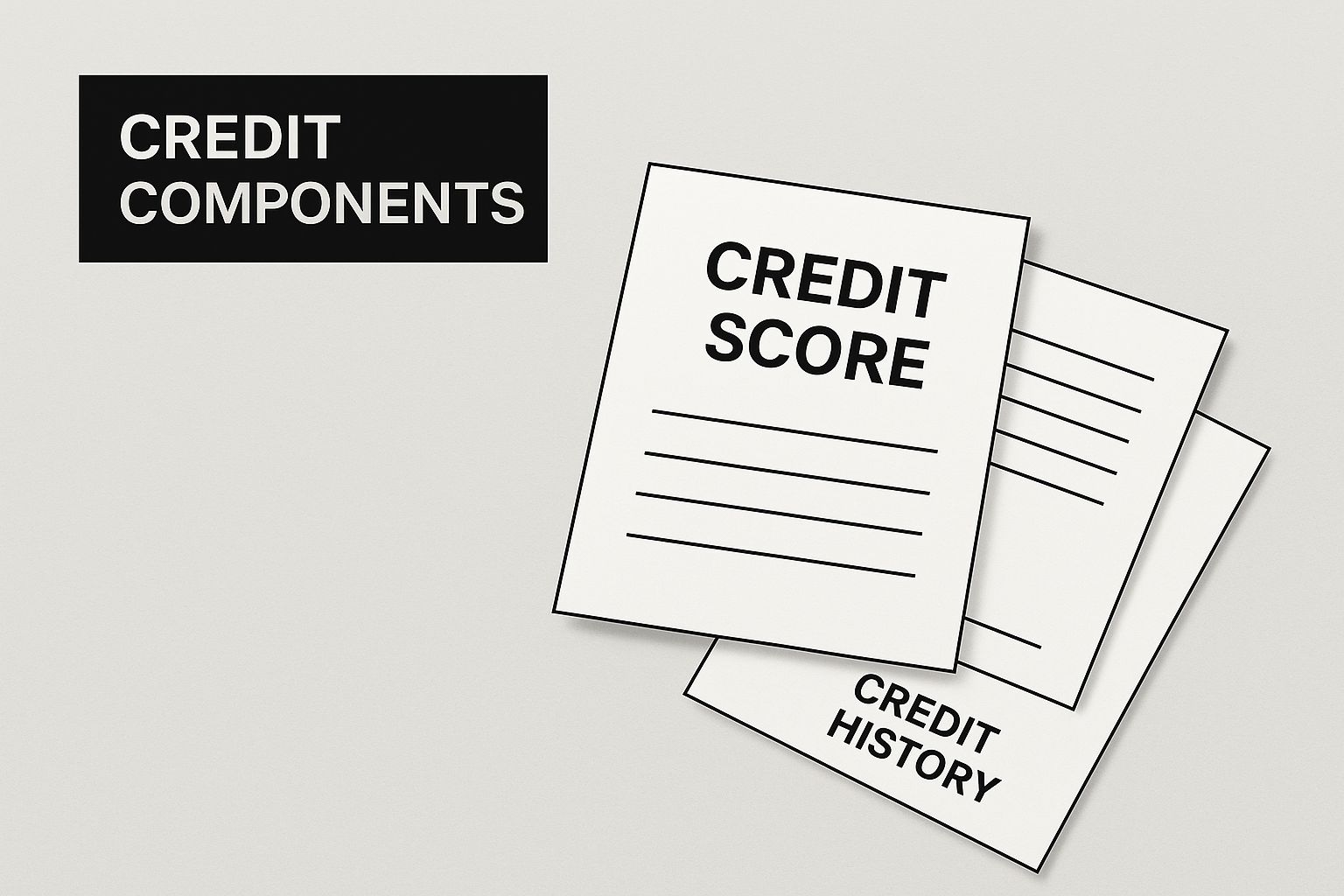Your Credit Report Explained Simply

Think of your credit report as your financial resume. It's not just a dry document; it's a detailed story of how you've handled money over the years. This story is what lenders, landlords, and sometimes even employers look at to gauge your reliability. The storytellers? Three major credit bureaus that collect and organize this data, effectively shaping your financial identity.
What Is a Credit Report?
A credit report is a detailed summary of your credit history. It’s the raw data behind your financial life story. Every time you've borrowed money—whether it was for a credit card, a car loan, or a mortgage—that activity has been noted and recorded.
This “resume” does more than just list who you owe money to. It paints a picture of your financial habits. Lenders study this picture carefully to predict how likely you are to pay back any new debt you take on. A report filled with on-time payments can open doors to better interest rates and more financial opportunities. On the other hand, a history of late payments or defaults can unfortunately close them.
The influence of this data is massive. For example, major economic shifts often highlight just how much a person's credit history impacts their life choices, as seen in a recent mortgage refinance surge in Australia. You can read more about these global consumer credit trends to get a sense of the bigger picture.

The Three Major Credit Bureaus
In the U.S., your financial story is gathered and managed by three main national credit bureaus, which are also called credit reporting agencies. While they are separate companies, they all collect very similar information from the places you do business with.
These three powerhouses are:
These companies are the keepers of your credit information. Your bank, credit card issuers, and other lenders report your activity to them—things like your account balances, how consistently you pay your bills, and your credit limits.
To help clarify their roles, here’s a quick breakdown of what these bureaus do.
The Three Major Credit Bureaus at a Glance
As you can see, each bureau acts as an independent record-keeper of your financial history, and lenders often look at reports from more than one before making a decision.
Why Do You Have Three Separate Reports?
So, why the three different versions of your financial resume? It's pretty simple: not all lenders report to all three bureaus.
Your credit card company might send your payment history to Experian and TransUnion, but your auto lender might report to all three. Or maybe your mortgage lender only reports to Equifax.
Because of this, the information on your Equifax, Experian, and TransUnion reports can have slight differences. This is exactly why checking all three of your reports regularly is so important. An error on just one report could go completely unnoticed if you only look at the other two, and that single error could be enough to get you denied for a loan. Getting a handle on this system is the first and most important step to managing your financial reputation.
How to Read the Four Key Sections of Your Report
Opening your credit report for the first time can be a little overwhelming. It's usually packed with codes, dates, and account numbers that might as well be a foreign language. But once you get the hang of its structure, it becomes an incredibly clear and powerful tool.
Think of it as the story of your financial life, told in four distinct chapters. We'll be your guide, walking you through each chapter so you can read your own story with confidence. Understanding these parts is the first step to spotting errors, verifying your information is correct, and truly taking control of your financial health.
This infographic gives you a great bird's-eye view of how all the pieces fit together.

As you can see, your report is built from a few core elements: your personal data, your account histories, any public financial records, and a log of who's been looking at your file. Let's break those down.
Section 1: Personal Information
This first section is pretty straightforward, but it’s critical to review it carefully. It’s basically your financial ID card, containing all the information that identifies you to lenders.
Here’s what you’ll find:
Why it matters: A simple typo in your name or an old address you don't recognize might not seem like a big deal. However, it could signal a simple clerical error or, in a worst-case scenario, identity theft. Lenders need to be absolutely sure they're reviewing the right person's file, so make sure every detail here is 100% accurate.
Section 2: Credit Accounts
This is the real meat of your credit report. This section lists out all your "tradelines," which is just industry-speak for every credit account you have or have had in the past. It’s a detailed history of your borrowing and repayment habits for each one.
For every account, you should see details like:
This is where your track record as a borrower is on full display. Lenders will zoom in on your payment history to see if you consistently pay on time, which is the single most important factor for building a strong credit profile.
Section 3: Public Records
This part of your report is reserved for financial events that have become a matter of public record. For most people, this section will be empty, and that’s a good thing. The items listed here are almost always negative and can seriously damage your creditworthiness.
Public records can include things like:
Because these are major financial setbacks, their presence can make it much harder to get new credit. It's vital to make sure any information here is correct and that it gets removed from your report once its legal time limit is up.
Section 4: Credit Inquiries
The last chapter of your report is a simple log of who has accessed your credit file. Every single time a person or company pulls your report, it's recorded as an inquiry. They fall into two very different categories.
This section is incredibly useful for keeping tabs on who's looking at your financial data. If you see a hard inquiry from a company you don't recognize, it could be a red flag that someone is trying to open an account in your name. Checking your inquiries regularly is a simple but powerful way to spot fraud early.
Decoding Your Account History and Payment Patterns
Think of your credit report as your financial story. If that’s the case, the "Account History" section is the most important chapter. This is where your financial habits come to life, providing a detailed, month-by-month record of how you handle every credit card and loan. It’s the raw data that shows lenders whether you’re a reliable borrower.
Let's break down a sample account entry piece by piece. Once you understand what you're looking at, you'll be able to read your own report with confidence, spot your good habits, and catch any red flags before they cause real trouble.

Reading the Tradeline Details
In the world of credit, each account you have—whether it's a credit card, car loan, or mortgage—is called a tradeline. It’s just industry jargon for an account entry. For every tradeline, you’ll find a block of information that gives a lender a complete picture of your relationship with that creditor.
Typically, this includes:
This basic info gives a quick overview, but the real meat is in your payment history. This is usually shown in a grid, detailing your payment behavior month after month.
Understanding the Payment History Grid
At first glance, the payment history grid can look like a confusing mess of codes and symbols. But it's actually pretty straightforward once you learn the language. While each credit bureau might use slightly different symbols, the meaning behind them is universal.
This grid is the single most important factor in your credit score, so getting comfortable with what it says is crucial for managing your financial health.
Decoding Your Payment History Codes
To make things easier, here's a quick reference guide for the most common codes you'll see in the payment history grid.
A perfect report will show a long string of "OK" or "C" statuses, which proves you handle credit responsibly. In contrast, seeing any numbers in this grid is a clear warning sign. A single 30-day late payment can remain on your credit report for a full seven years.
Key Data Points Lenders Analyze
Lenders look beyond just your on-time payments. They zoom in on other details to get a full sense of your financial risk. Two of the most critical metrics are your account age and credit utilization.
Account Age Lenders value stability. They prefer to see long-standing accounts that have been managed well over time. The "Date Opened" field helps them figure out the average age of all your accounts. This is why closing your oldest credit cards, even if you don't use them, can sometimes cause a small dip in your score—it lowers your average account age.
Credit Utilization This is a big one. Your credit utilization ratio shows how much of your available revolving credit you're currently using. It's calculated by dividing your current credit card balance by your total credit limit. For example, a 500** balance on a card with a **1,000 limit results in a 50% utilization ratio. High utilization signals to lenders that you might be financially stressed. As a rule of thumb, most experts recommend keeping this ratio below 30%.
The system that compiles all this information has a rich history, evolving from simple local ledgers into a powerhouse industry that underpins over $4 trillion in lending each year. If you're curious, you can discover more insights about the evolution of credit data and how it became so central to our economy. By mastering this section of your report, you’re not just reading numbers—you're taking control of your financial narrative.
When you're scanning your credit report, it's easy to gloss over certain sections. But let's zoom in on two parts that can tell lenders a whole lot about you: Credit Inquiries and Public Records. Think of them as the footnotes in your financial story—they might seem small, but they often have a major impact on the final decision.
Getting a handle on what these sections mean is key to managing your credit. A negative or even just a misunderstood entry here can be surprisingly damaging, so let's break down what you're actually looking at.
The Two Flavors of Credit Inquiries
Every time someone pulls your credit file, a little note gets made. This is an "inquiry." It’s like a log of who's been peeking at your financial history. But not all peeks are the same. They come in two distinct flavors: hard and soft.
1. Hard Inquiries (Hard Pulls) A hard inquiry pops up when you officially apply for something that involves borrowing money. We're talking about mortgage applications, car loans, new credit cards—you name it. You’re asking for new credit, so lenders take a close look. From their perspective, you're potentially taking on more debt, which adds a bit of risk.
One or two hard pulls aren't a big deal; they might ding your score by a few points temporarily. The real trouble starts when you have a lot of them in a short time. This can look like you're desperate for cash, making lenders nervous.
2. Soft Inquiries (Soft Pulls) Then there are soft inquiries. These happen all the time in the background and have zero impact on your credit score. You can rest easy about these.
Here’s when a soft pull might happen:
This section is also a fantastic tool for spotting fraud. If you see a hard inquiry from a bank you've never heard of, it's a huge red flag that someone might be trying to open an account using your identity.